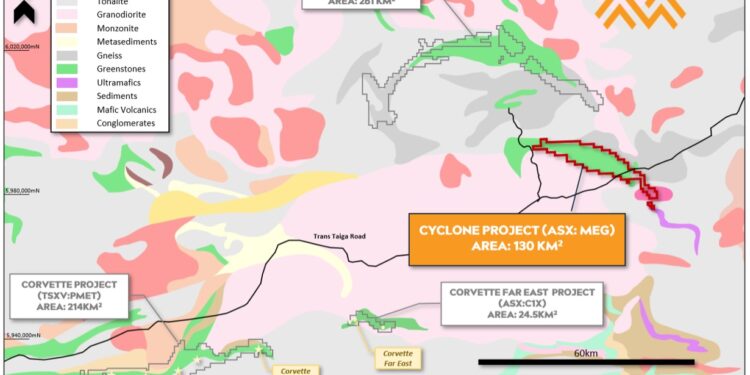Megado Minerals Limited (ASX: MEG) identified lithium potential via a detailed interpretation of hyperspectral imagery over its Cyclone Lithium Project in Canada.
Terra Resources was engaged by Megado to conduct a detailed interpretation of hyperspectral imagery targeting lithium bearing pegmatite within the project area. Terra has a track record of successfully identifying lithium occurrences from remote sensing datasets, particularly in the James Bay Region. The interpretation by Terra relied on Aster and Sentinel-2 satellite imagery, in conjunction with proprietary algorithms that target lithium bearing pegmatites.
Terra’s analyses identified 415 occurrences of potential lithium bearing pegmatite within the 130sq. km Cyclone Project area. The interpretation was aided by the correlation of historically identified pegmatite occurrences and known lithium spectral bands to provide the most robust results. Importantly, there appears to be nine semi-contiguous clusters of occurrences within the greenstone belt – this is critical for the potential to build significant tonnage of possible mineralized rock. Clusters range in size but are generally over 4km in length, with individual targets in the order of 10’s to 100’s of metres in length. A number of these clusters are present within proximity to main road access into the Cyclone Project area.
“The outcomes of this survey work has exceeded our expectations. To identify 400+ potential lithium bearing pegmatite outcrops in nine distinct areas, shows that our underlying thesis regarding the prospectivity for lithium at Cyclone Project is sound,” CEO and MD, Ben Pearson, said.
“This is a belt that has not previously been explored for lithium. The potential for a discovery within the area is now significantly more favourable, especially given the success of our peers in similar greenstone belts.
“We are excited to follow up this work with a systematic program of ground truthing during the upcoming summer field season.”
Future Work Programmes at Cyclone
Another remote sensing programme is also underway, utilizing high resolution satellite imagery and detailed topography to perform a structural analysis of the Cyclone Project. The aim of this work is to provide an additional data layer to aid initial field work and drill targeting, and to identify areas of possible pegmatite mineralization that may be under cover. Results from this work will be announced once completed.
A more detailed review of these hyperspectral targets will be done, in combination with existing datasets of government mapping, high-resolution geophysics (previously acquired), and the upcoming high-resolution topography and satellite imagery based detailed structural analysis of the Cyclone Project. These datasets will be reviewed in combination to determine possible controls to pegmatite mineralization, influence of glaciation and morphology versus host rock controls, and prospectivity of the target areas to develop a probabilistic ranking of targets.
Logistics planning is ongoing, looking to start the field season once the snow has cleared with drilling anticipated later in the season.
For further information please visit: https://megadominerals.com/












